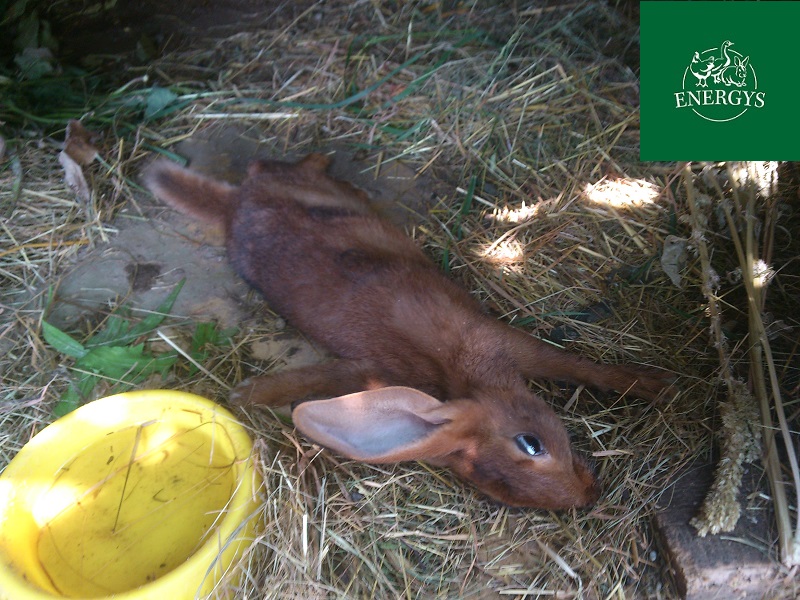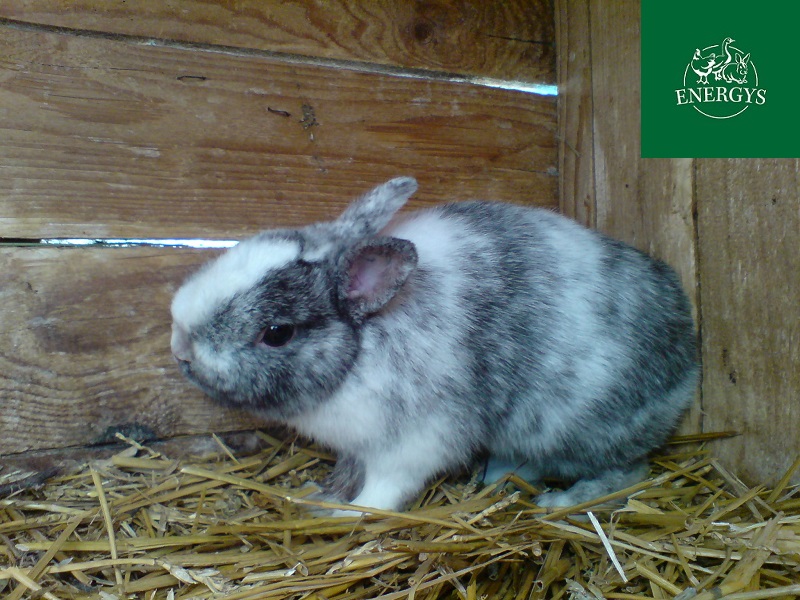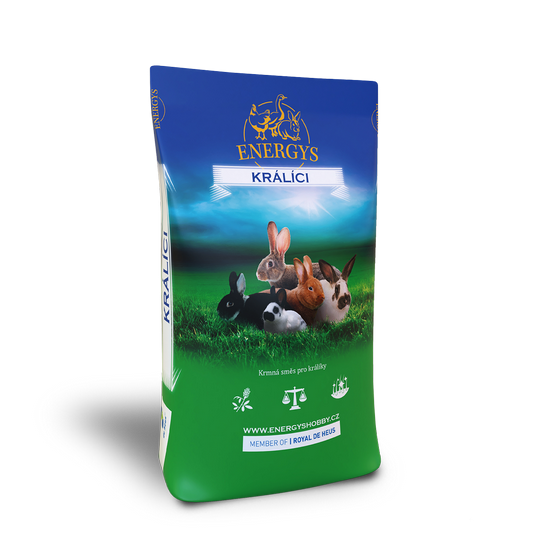Rabbits
Poultry
Laying hens
Quails
Guinea pigs
Pigs
Ostriches
Sheep and goats
Pigeons
Pheasants
Forest animals
The Most Common Diseases of Rabbits and Their Prevention
Although there may be only a few diseases affecting rabbits (compared to dogs and cats), it goes without saying that the aim is to maintain good health. Infectious diseases are those caused by germs (viruses, bacteria, parasites, fungi) and spread among animals.
Infectious diseases may spread directly by contact with an infected animal (by skin contact, secretions and excreta, etc.) or indirectly. The indirect form of spreading is not to be underestimated, because transmission takes place through infected feed, drinking water, litter, as well as breeding aids or breeders’ clothing.
The most common infectious diseases of rabbits
The lower indicated diseases appear most frequently:
Rabbit plague (RHD, VHD, hemorrhagic septicemia of rabbits)
Viral rapid-going disease in rabbits, which spreads rapidly, has high morbidity and mortality. The transmission is direct or indirect. A frequent description of breeders is the sudden death of a rabbit with symptoms of choking, whereby non-clotted blood may come out of the nose. At autopsy, organ bleeds are detected with a predominant pathological change in the liver. In 2017, a new form of the disease, called RHDV2, was diagnosed in the Czech Republic.. There is no treatment.
Effective prevention means vaccination according to the vaccine manufacturer’s scheme. In breeding practice, it is recommended to vaccinate breeding rabbits twice a year.

Fig. 1: – Sudden death is often described in rabbit plague
Myxomatosis
Viral rapid disease, characterized by the formation of pathological changes to the skin and high fever. Transmission is direct or indirect (primarily through blood-sucking insects). A few days after infection, general symptoms of the disease later occur, accompanied by characteristic formation of myxomas in the skin of rabbits, especially on the head. The occurrence of the disease is associated with the culmination of stinging insects. Recently, the Czech Republic has encountered less pronounced clinical manifestations, when a larger proportion of individuals are able to recover, but they still have myxoma scars. Treatment is not performed.
Effective prevention means vaccination according to the vaccine manufacturer’s scheme. In breeding practice, it is recommended to vaccinate breeding rabbits twice a year.
Encephalitozoon
Diseases caused by the microsporidial parasite Encephalitozoon cuniculi. In the Czech Republic, this disease has recently been diagnosed more frequently, especially in pet rabbits. In general, it has been shown that the causative agent was carried by a significant proportion of rabbits for a relatively long time – without any apparent pathological manifestation. Clinical symptoms of the disease are mainly associated with stress and greater strain on the body (e.g. summer temperatures, extreme cold, exhaustion, convalescence after illness, pregnancy and rearing of offspring, etc.). The main clinical symptoms are tilting the head to the side (resulting in irregular movement, no movement possible in the end stage) and kidney problems. Treatment exists, but is long-term and uncertain, especially if therapy is started later.

Fig. 2: Neurological symptoms of encephalitozoonosis
Coccidiosis
It is a parasitic disease caused by intestinal coccidia – single-cell parasites of the genus Eimeria. Developmental stages are transmitted by the ingestion of feces. The critical age for infecting offspring is 5-7 weeks. Sick offspring are apathetic, hunched, dehydrated, with a serrated back and grind their teeth. Coccidiosis can be treated in the initial phase of the disease, in more advanced conditions the prognosis is unfavorable. Prevention consists of good nutrition and good environmental hygiene.
Ear mange
It is a parasitic disease caused by rabbit mumps (Psoroptes cuniculi), which is characterized by crustitis of the ear and the external auditory canal and severe itching. It is transmitted directly and indirectly. Treat with appropriate anti-parasitic agents.
Cheyletiellosis
It is a parasitic disease caused by the mite Cheyletiella parasitovorax, resulting in a scaly inflammation of the skin in the back and backbone area. Modern scientific publications consider the mite as merely a commensal, while its overgrowth and parasitism occur when the organism weakens. It is transmitted directly and indirectly. The disease is typically more likely to be found in older rabbits. The treatment is similar to that of ear mites.
Rabbit syphilis
It is a bacterial, chronic disease caused by the spirochete Treponema cuniculi, which is characterized by the formation of crustic changes on the skin and mucous membranes of the genitals, later on the head and ears. The disease has a protracted course, clinical manifestations may occur only 2 months after the infection (mostly directly at the coitus, other ways of transmission are discussed). The disease is treatable with injected antibiotics. Prevention is to control the health of rabbits before pairing.
Rabbit rhinitis
It is a bacterial disease that lasts for various periods of time with a prevalence of respiratory problems. The effect of the bacteria Pasteurella multocida (pasteurellosis) is considered essential, but the condition is almost always accompanied by pathological action of other bacteria. Many of these species naturally populate the airways of the rabbit and show pathological effects only when the organism is weakened (higher ammonia concentration in the air, higher humidity, overcrowded pens, mixed groups of rabbits from different breeds, etc.). Other symptoms may include the formation of abscesses in the skin or internal organs. The disease is transmitted directly or indirectly. Droplet infection, however, only at a short distance (specific breeding). Treatment exists but is complicated.
Disease diagnosis and treatment
The diagnosis and treatment of sick rabbits is the responsibility of a veterinarian.
It follows from the above description of the disease that a number of diseases in rabbits are caused or complicated by improper practices in housing, feeding and handling rabbits. Therefore, the approach to maintaining good rabbit health should be comprehensive, so-called preventive medicine, where the farmer should ensure an optimal level of nutrition, zootechnics and zoohygiene backed by regular veterinary care. With this approach, it is possible to prevent the selected rabbit diseases.

Fig. 3: Healthy rabbit
Related posts
10. April 2024
Keeping dwarf rabbits as pets is becoming increasingly popular. It does not require a lot of space and is ideal for people who live in smaller homes or apartments. Dwarf rabbits are also very friendly, so it’s no wonder that people are choosing them for this purpose more and more often. As with all animals,…
30. August 2022
In this article we will discuss several rabbit diseases – ear scab, tyzzer’s disease and heat stress.
24. August 2022
In this article we look at two diseases – e.Coli and enterocolitis.
2. August 2022
In this article we look at two common rabbit diseases, myxomatosis and infectious rhinitis.
13. July 2022
In the following article we will discuss rabbit plague – rhd or vhd (viral haemorrhagic disease of rabbits).
Related products

RABBIT DWART
Complete pelleted feed for dwarf rabbits with high digestibility. It contains a high proportion of fibre (high alfalfa and grass cake content) and a reduced sugar and starch content. Contains flaxseed, which has a positive effect on coat quality. Suitable for daily feeding. We recommend providing rabbits with safe fresh water and hay.

RABBIT CHAMPION
Feed for show rabbits, does not include Coccidiostat. A unique mix significantly supports the quality and growth of fur. Serve when moulting and at least two months before the start of the show season.

RABBIT GOLD FORTE
A premium feed mix in an ideal make up for gestating and breast feeding females. For the intensive fattening of rabbits for a period of up to 5 days before slaughter. It supports fast growth, meat content and an excellent state of health. It contains a coccidiostat which lowers the risk of mortality.

RABBIT KLASIK FORTE
Intended for the fattening of rabbits up to a point at least 5 days before slaughter. Suitable for attaining a high meat content and an excellent state of health. Thanks to its Coccidiostat content it lowers the animals mortality.

RABBIT KLASIK
For the final phase of rabbit fattening, a minimum of 5 days before slaughter. It supports high meat content and excellent taste qualities in rabbit meat. Without a coccidiostat.

RABBIT START
For young rabbits from the start of accepting feed to 4-6 weeks after weaning. The feed helps to significantly lower the death rate in the period around weaning. It contains a raised percentage of fibre and less starch. It does not contain a coccidiostat.
